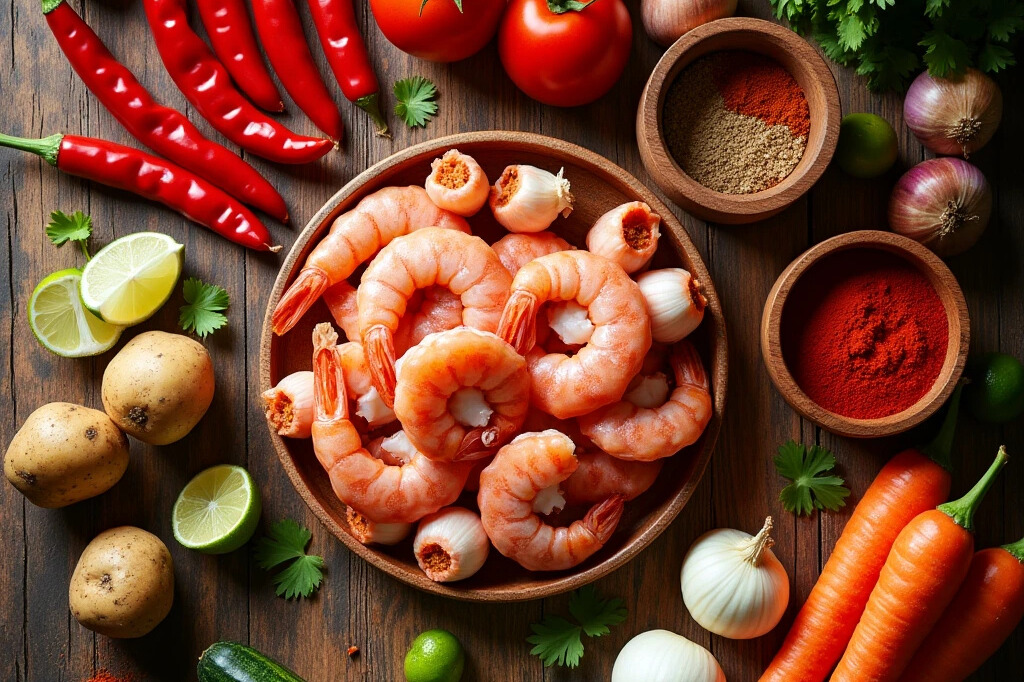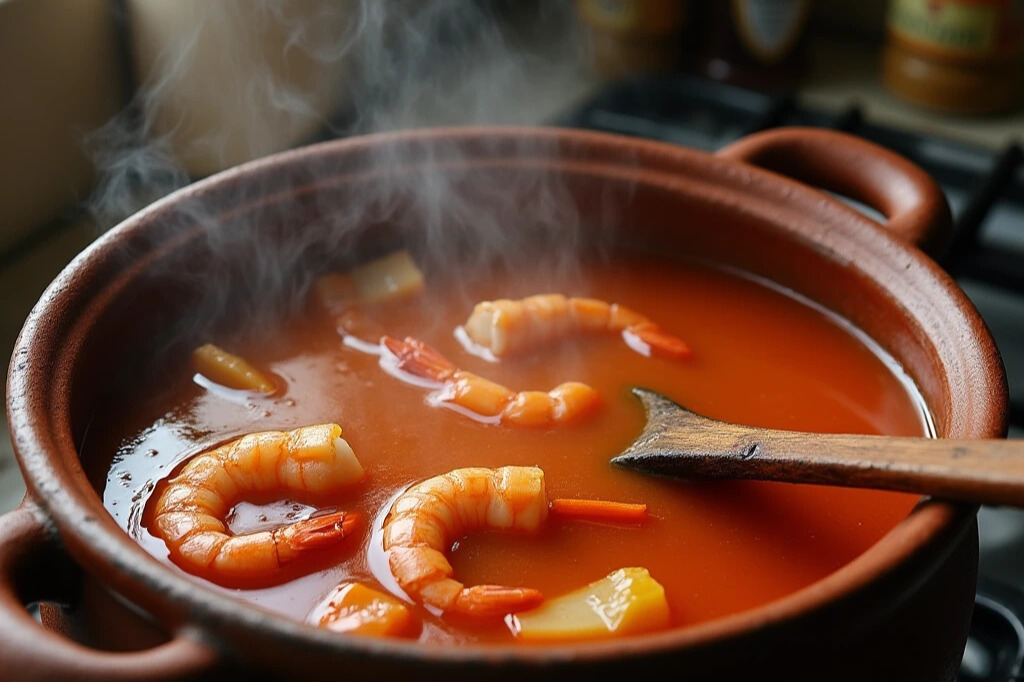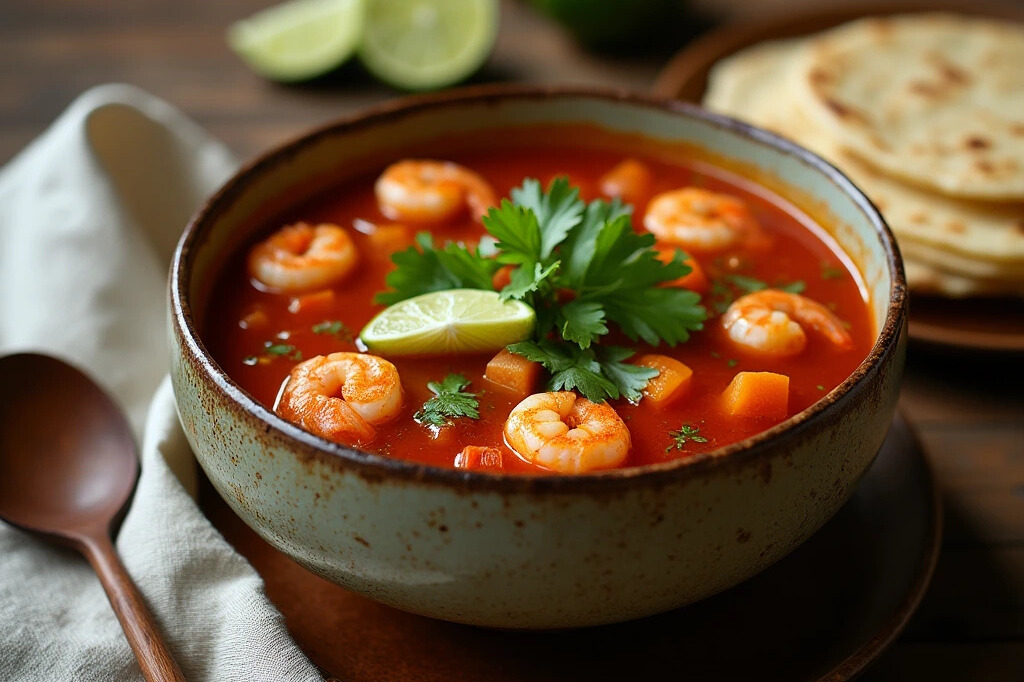When it comes to traditional Mexican dishes, Caldo de Camaron takes center stage with its rich, aromatic broth, succulent shrimp, and hearty vegetables. Rooted in the coastal regions of Mexico, this comforting shrimp soup is a favorite for its vibrant flavors and nourishing qualities. Whether enjoyed during Lent or as a soulful meal on a cold day, this dish has a universal appeal that transcends cultures and borders. Let’s dive deep into the history, preparation, and unique charm of this culinary gem.
What is Caldo de Camaron?
Caldo de Camaron, directly translating to “shrimp broth,” is a quintessential Mexican seafood dish. Packed with protein-rich shrimp, simmered vegetables, and an earthy chile-based broth, it offers a balance of spice, flavor, and nutrition. This dish is cherished across Mexico for its simplicity and versatility.
Originating as a staple in coastal regions, this soup reflects the Mexican coastline’s abundant seafood resources and culinary ingenuity. Over time, it has made its way into homes and restaurants worldwide, gaining fame for its robust flavors.
Historical Background of Caldo de Camaron
Tracing the origins of Caldo de Camaron leads us to Mexico’s maritime communities, where fresh seafood is a cornerstone of daily life. The soup was traditionally crafted as a humble yet hearty meal for fishermen, using readily available shrimp and regional spices. Over the centuries, its popularity grew, becoming a staple during Lent when red meat consumption is limited.
The dish also carries regional variations, incorporating local ingredients to showcase the diverse culinary tapestry of Mexico. For instance, in some areas, dried shrimp is used instead of fresh, giving the soup a slightly different texture and flavor profile.
Cultural Significance of Caldo de Camaron
Beyond its flavor, Caldo de Camaron holds deep cultural significance. This dish represents comfort, family gatherings, and traditional practices passed down through generations. It’s a common sight during festive occasions, bringing people together around a shared meal.
Particularly during Lent and Holy Week, this shrimp soup plays a starring role, offering a fulfilling alternative to meat-based dishes. Its rich, red-hued broth—often enhanced with guajillo chiles—symbolizes the vibrant culture of Mexican cuisine, while the shrimp and vegetables make it a wholesome choice for all ages.
Ingredients and Preparation
Creating a flavorful Caldo de Camaron starts with selecting the right ingredients and following key preparation steps. Each component, from fresh produce to aromatic spices, plays a critical role in achieving the soup’s distinctive taste.

Essential Ingredients
A perfect Caldo de Camaron relies on a handful of essential ingredients:
- Fresh Shrimp: Provides protein and depth to the soup.
- Guajillo Chiles: Impart a mild, smoky heat with their earthy notes.
- Tomatoes: Add a natural sweetness to balance the broth’s flavors.
- Onions and Garlic: Build the aromatic foundation for the soup.
- Vegetables: Staples like potatoes, carrots, and zucchini add texture and nutrients.
- Herbs and Seasonings: Epazote or cilantro, combined with salt and pepper, elevate the dish’s aromatic profile.
These ingredients, when combined thoughtfully, create the complex yet comforting flavors Caldo de Camaron is known for.
Selecting Fresh Shrimp
The quality of shrimp can make or break your Caldo de Camaron. To ensure optimal taste:
- Look for shrimp that are firm, translucent, and have a mild sea scent.
- Avoid shrimp with black spots or an ammonia-like smell, as these are signs of spoilage.
- For convenience, you can use peeled and deveined shrimp, but retaining the shells adds flavor to the broth.
Pro tip: Purchase shrimp fresh if possible, or opt for high-quality frozen shrimp if fresh isn’t available. Thaw frozen shrimp slowly in the refrigerator to preserve their texture and flavor.
Preparing the Broth
The broth is the soul of Caldo de Camaron, and it begins with a robust base made from shrimp shells and aromatics.
- Simmer the Shells: In a large pot, add the shrimp shells, water, a few slices of onion, garlic, and a pinch of salt. Simmer for about 30 minutes.
- Strain the Broth: Remove the shells and aromatics, leaving a clear and flavorful liquid. This liquid becomes the backbone of your soup.
- Enhance with Chiles: Blend roasted and soaked guajillo chiles with a small amount of broth and strained tomato puree. Add this mixture back into the pot for a vibrant red hue and a kick of spice.
Taking the time to create a homemade broth ensures a depth of flavor that pre-made stocks simply cannot replicate.
Incorporating Vegetables
Vegetables are essential for adding texture, color, and nutrients to the soup. Here’s how to prepare them:
- Potatoes and Carrots: Peel and chop into bite-sized pieces. These are added early to the broth, allowing them to soften.
- Zucchini: Slice thinly and add later in the cooking process to maintain a slight crunch.
- Optional Add-Ins: Corn kernels or green beans can provide additional texture and flavor.
By staggering when each vegetable is added, you can ensure perfect doneness and a balanced texture throughout the soup.
Spice and Seasoning
The distinct flavor of Caldo de Camaron comes from the careful use of spices and herbs.
- Guajillo Chiles: Toast them lightly before soaking, as this unlocks their smoky aroma.
- Seasoning: Taste the broth frequently as you add salt and pepper, ensuring the flavors are balanced.
- Herbs: Add epazote or fresh cilantro at the end of cooking to preserve their fresh, bright notes.
This combination of spices and seasonings provides a delicate balance of heat, earthiness, and freshness that’s unique to this dish.
Cooking Techniques
Perfecting Caldo de Camaron requires not only quality ingredients but also the right cooking methods. Each technique, from roasting chiles to simmering the broth, plays a crucial role in building the dish’s deep, savory flavor.
Roasting and Soaking Chiles
To unlock the full potential of guajillo chiles, roasting is an essential first step.
- Roasting: Lightly toast the chiles in a dry skillet over medium heat, pressing them down gently with a spatula. This process releases their natural oils, enhancing their smoky aroma and flavor. Be careful not to burn them, as this can impart a bitter taste.
- Soaking: After roasting, place the chiles in a bowl of hot water for 15–20 minutes. This softens their skin, making them easy to blend into a smooth paste. The soaking water can be strained and added to the broth for an extra layer of flavor.
This step infuses the soup with the chiles’ signature smoky warmth, creating a robust base for the dish.
Sautéing Aromatics
The foundation of any great soup lies in its aromatics, and Caldo de Camaron is no exception.
- Onions and Garlic: Dice the onions finely and mince the garlic. Sauté them in a bit of oil until they turn translucent and fragrant. This step caramelizes their natural sugars, enhancing their sweetness and depth.
- Optional Additions: For added complexity, include a chopped tomato or a pinch of ground cumin during this stage.
By taking the time to sauté these ingredients, you create a flavorful base that complements the earthy richness of the guajillo chiles.
Simmering the Broth
Doing this is where the magic happens, transforming a simple pot of ingredients into a harmonious soup.
- Shrimp Shells: Start by adding the shrimp shells to a large pot of water, along with onion slices, garlic, and a bay leaf. Simmer for about 30 minutes to extract their flavor.
- Strain the Broth: Remove the shells and aromatics, leaving a clear, flavorful liquid as your base.
- Blend Chiles: Blend the soaked guajillo chiles with a small amount of broth and a few tomatoes. Add this mixture back to the pot, stirring well.
- Add Vegetables: Incorporate chopped potatoes and carrots early, giving them time to soften. Add zucchini or other delicate vegetables towards the end to maintain their texture.
Simmering the broth slowly allows the flavors to meld together, creating a rich and deeply satisfying soup.
Cooking the Shrimp

Shrimp is the star of Caldo de Camaron, and cooking it just right is key to preserving its tender texture.
- Timing: Add the shrimp during the last 5–7 minutes of cooking, as overcooking can make them rubbery.
- Even Cooking: Ensure the shrimp are fully submerged in the broth for even cooking. You’ll know they’re done when they turn opaque and slightly pink.
- Final Touches: Adjust the seasoning with salt, pepper, and a squeeze of lime juice before serving.
This careful timing ensures that the shrimp remain succulent, providing the perfect bite in every spoonful.
Serving Suggestions
Once your Caldo de Camaron is prepared, the right accompaniments and garnishes can elevate your dining experience. Traditionally served with warm tortillas and bright, fresh garnishes, this dish offers endless possibilities to make it your own.
Traditional Accompaniments
Serving Caldo de Camaron with thoughtful accompaniments enhances its flavors and adds to its authentic charm:
- Corn Tortillas: Soft, warm corn tortillas are a must. They can be dipped into the broth or used to scoop up shrimp and vegetables.
- Lime Wedges: A squeeze of lime juice adds a zesty kick that complements the smoky, earthy tones of the broth.
- Fresh Cilantro: A handful of chopped cilantro not only brightens the soup’s flavor but also adds a vibrant pop of green.
- Rice or Crackers: While not always traditional, some regions serve the soup alongside white rice or salty crackers for added texture.
These accompaniments transform a simple bowl of soup into a hearty, complete meal.
Garnishing Ideas
The finishing touches are where you can truly personalize your Caldo de Camaron:
- Diced Onions: Add a sharp, fresh crunch that contrasts beautifully with the smooth broth.
- Avocado Slices: Creamy avocado tempers the heat of the chiles and adds a luxurious texture.
- Oregano Sprinkle: A light dusting of dried oregano enhances the soup’s earthy undertones.
Garnishing not only adds layers of flavor but also elevates the presentation, making the dish as visually appealing as it is delicious.
Beverage Pairings
To complement the robust flavors of Caldo de Camaron, consider pairing it with refreshing, non-alcoholic beverages:
- Agua Fresca: Flavors like tamarind or hibiscus provide a sweet, tangy contrast to the soup’s savory profile.
- Citrus Juices: Freshly squeezed orange or grapefruit juice highlights the bright notes of lime and cilantro.
- Mineral Water: A sparkling water with a hint of lime is a simple, refreshing choice.
These beverages cleanse the palate between bites, letting you savor every spoonful of this rich, flavorful soup.
Nutritional Information
Beyond its delicious taste, Caldo de Camaron is a nutrient-packed meal, offering health benefits and fitting various dietary needs.
Health Benefits
Packed with essential nutrients, Caldo de Camaron offers a range of health benefits:
- High in Protein: Shrimp is an excellent source of lean protein, which supports muscle growth and repair.
- Rich in Antioxidants: Guajillo chiles and tomatoes contain antioxidants that help reduce inflammation and support heart health.
- Low in Fat: Despite its rich flavor, the soup remains low in fat, making it a heart-healthy choice.
- Vitamin-Rich: Vegetables like carrots and potatoes add vitamins A and C, boosting immunity and skin health.
With its balance of nutrients, this dish supports overall wellness while delighting your taste buds.
Caloric Content
A typical serving of Caldo de Camaron provides approximately 200 calories, making it a light yet filling meal option.
- Shrimp: Low in calories but high in protein.
- Broth: A flavorful base with minimal fat.
- Vegetables: Packed with fiber and nutrients, they add volume without significantly increasing calorie count.
This calorie-conscious profile makes the soup suitable for those watching their intake while enjoying a satisfying meal.
Dietary Considerations
Caldo de Camaron is naturally accommodating to various dietary preferences and restrictions:
- Gluten-Free: The soup is made without any gluten-containing ingredients, making it safe for those with gluten intolerance.
- Low-Sodium Adaptations: By adjusting the salt levels and using low-sodium broth, this dish can be tailored to meet dietary needs.
- Keto-Friendly Options: For those following a ketogenic diet, simply reduce the potatoes and add more zucchini or green beans.
These adaptations ensure that everyone can enjoy the rich, comforting flavors of this Mexican classic.
Variations of Caldo de Camaron
One of the most captivating aspects of Caldo de Camaron is its adaptability. This dish evolves with regional influences, modern innovations, and dietary preferences, proving its universal appeal.
Regional Differences
Across Mexico, Caldo de Camaron takes on unique characteristics that reflect the local cuisine and traditions:
- Southern Mexico: Plantains and yucca are often added, infusing the soup with subtle sweetness and a tropical twist.
- Veracruz: This coastal region is known for adding fresh jalapeños and a dash of citrus, giving the soup a tangy kick.
- Northern Mexico: Dried shrimp is a popular substitute for fresh shrimp, adding an intense, concentrated flavor.
These variations showcase the diversity of Mexican culinary traditions while preserving the soul of Caldo de Camaron.
Modern Twists
Chefs and home cooks worldwide have embraced Caldo de Camaron, adding creative elements to cater to contemporary tastes:
- Coconut Milk: A creamy, tropical addition that complements the smoky guajillo chiles.
- Quinoa: A high-protein grain that enhances the soup’s nutritional value while providing a slightly nutty flavor.
- Fusion Flavors: Some recipes incorporate lemongrass or ginger for an Asian-inspired touch.
These modern twists offer new dimensions to the traditional recipe, appealing to adventurous palates.
Vegetarian Alternatives
For those who prefer plant-based meals, Caldo de Camaron can be easily adapted into a vegetarian delight:
- Hearty Vegetables: Substitute shrimp with mushrooms, cauliflower, or artichoke hearts to mimic the soup’s texture.
- Vegetable Broth: Use a well-seasoned broth made with roasted vegetables, garlic, and herbs as the base.
- Tofu or Tempeh: These protein-rich options absorb the soup’s spices, adding a satisfying bite.
This vegetarian version retains the essence of the dish while accommodating dietary restrictions.

